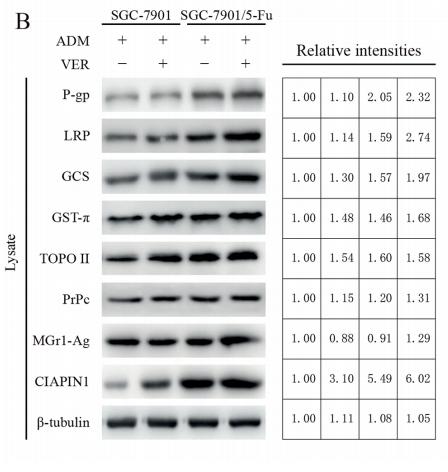GCS alpha-1 Antibody - #DF8551
| Product: | GCS alpha-1 Antibody |
| Catalog: | DF8551 |
| Description: | Rabbit polyclonal antibody to GCS alpha-1 |
| Application: | WB IHC |
| Cited expt.: | WB |
| Reactivity: | Human, Mouse, Rat |
| Prediction: | Pig, Bovine, Dog |
| Mol.Wt.: | 77 kDa; 77kD(Calculated). |
| Uniprot: | Q02108 |
| RRID: | AB_2841755 |
Related Downloads
Protocols
Product Info
*The optimal dilutions should be determined by the end user. For optimal experimental results, antibody reuse is not recommended.
*Tips:
WB: For western blot detection of denatured protein samples. IHC: For immunohistochemical detection of paraffin sections (IHC-p) or frozen sections (IHC-f) of tissue samples. IF/ICC: For immunofluorescence detection of cell samples. ELISA(peptide): For ELISA detection of antigenic peptide.
Cite Format: Affinity Biosciences Cat# DF8551, RRID:AB_2841755.
Fold/Unfold
GC S alpha 1; GC SA3; GCS alpha 1; GCS alpha 3; GCS-alpha-1; GCS-alpha-3; GCYA3_HUMAN; Guanylate cyclase 1 soluble alpha 3; Guanylate cyclase soluble subunit alpha 1; Guanylate cyclase soluble subunit alpha 3; Guanylate cyclase soluble subunit alpha-3; Guanylate cyclase, nitric oxide-sensitive, alpha-1 subunit; Guc1a1; GUC1A3; GUCA3; GUCSA3; Gucy1a1; Gucy1a3; MYMY6; nitric oxide-sensitive Guanylate cyclase, alpha-1 subunit; NOGC, alpha-1 subunit; Soluble guanylate cyclase large subunit;
Immunogens
A synthesized peptide derived from human GCS alpha-1, corresponding to a region within C-terminal amino acids.
- Q02108 GCYA1_HUMAN:
- Protein BLAST With
- NCBI/
- ExPASy/
- Uniprot
MFCTKLKDLKITGECPFSLLAPGQVPNESSEEAAGSSESCKATVPICQDIPEKNIQESLPQRKTSRSRVYLHTLAESICKLIFPEFERLNVALQRTLAKHKIKESRKSLEREDFEKTIAEQAVAAGVPVEVIKESLGEEVFKICYEEDENILGVVGGTLKDFLNSFSTLLKQSSHCQEAGKRGRLEDASILCLDKEDDFLHVYYFFPKRTTSLILPGIIKAAAHVLYETEVEVSLMPPCFHNDCSEFVNQPYLLYSVHMKSTKPSLSPSKPQSSLVIPTSLFCKTFPFHFMFDKDMTILQFGNGIRRLMNRRDFQGKPNFEEYFEILTPKINQTFSGIMTMLNMQFVVRVRRWDNSVKKSSRVMDLKGQMIYIVESSAILFLGSPCVDRLEDFTGRGLYLSDIPIHNALRDVVLIGEQARAQDGLKKRLGKLKATLEQAHQALEEEKKKTVDLLCSIFPCEVAQQLWQGQVVQAKKFSNVTMLFSDIVGFTAICSQCSPLQVITMLNALYTRFDQQCGELDVYKVETIGDAYCVAGGLHKESDTHAVQIALMALKMMELSDEVMSPHGEPIKMRIGLHSGSVFAGVVGVKMPRYCLFGNNVTLANKFESCSVPRKINVSPTTYRLLKDCPGFVFTPRSREELPPNFPSEIPGICHFLDAYQQGTNSKPCFQKKDVEDGNANFLGKASGID
Predictions
Score>80(red) has high confidence and is suggested to be used for WB detection. *The prediction model is mainly based on the alignment of immunogen sequences, the results are for reference only, not as the basis of quality assurance.
High(score>80) Medium(80>score>50) Low(score<50) No confidence
Research Backgrounds
Cytoplasm.
Detected in brain cortex and lung (at protein level).
Belongs to the adenylyl cyclase class-4/guanylyl cyclase family.
Research Fields
· Cellular Processes > Cellular community - eukaryotes > Gap junction. (View pathway)
· Environmental Information Processing > Signal transduction > cGMP-PKG signaling pathway. (View pathway)
· Metabolism > Nucleotide metabolism > Purine metabolism.
· Organismal Systems > Circulatory system > Vascular smooth muscle contraction. (View pathway)
· Organismal Systems > Immune system > Platelet activation. (View pathway)
· Organismal Systems > Environmental adaptation > Circadian entrainment.
· Organismal Systems > Nervous system > Long-term depression.
· Organismal Systems > Endocrine system > Oxytocin signaling pathway.
· Organismal Systems > Endocrine system > Renin secretion.
· Organismal Systems > Digestive system > Salivary secretion.
References
Application: WB Species: human Sample: GC cells
Restrictive clause
Affinity Biosciences tests all products strictly. Citations are provided as a resource for additional applications that have not been validated by Affinity Biosciences. Please choose the appropriate format for each application and consult Materials and Methods sections for additional details about the use of any product in these publications.
For Research Use Only.
Not for use in diagnostic or therapeutic procedures. Not for resale. Not for distribution without written consent. Affinity Biosciences will not be held responsible for patent infringement or other violations that may occur with the use of our products. Affinity Biosciences, Affinity Biosciences Logo and all other trademarks are the property of Affinity Biosciences LTD.
